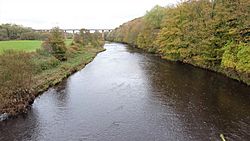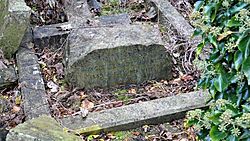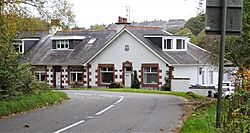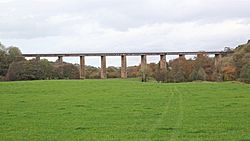Castle and Barony of Gadgirth facts for kids
Quick facts for kids Castle and Barony of Gadgirth |
|
|---|---|
| Gadgirth, Annbank, South Ayrshire, Scotland | |

The River Ayr from Gadgirth Bridge with Gadgirth Woods and Viaduct.
|
|
| Coordinates | 55°28′07″N 4°31′06″W / 55.468732°N 4.5184681°W |
| Type | Castle |
| Site information | |
| Owner | Private land |
| Open to the public |
No |
| Condition | Demolished and replaced by Gadgirth House |
| Site history | |
| Built | 14th Century |
| Built by | Chalmer |
| Materials | Masonry |
The Castle and Barony of Gadgirth was a historic estate in Scotland. It was owned by the Chalmer family for many years. This important place included castles and a large house. It was located near the River Ayr in South Ayrshire.
Contents
Exploring Gadgirth's Past
Who Lived at Gadgirth Castle?
The Chalmer family, originally called De Camera, owned Gadgirth for a very long time. They first got the land during the time of King William the Lion (1165-1214). The family lived there until around 1761. Later, in 1800, Colonel Joseph Burnett bought part of the estate. This included the sites of Gadgirth and Gadgirth Old Ha' Castles.
The name 'Chalmer' comes from an old job title. It means 'Lord or Great Chamberlain of Scotland'. This was a high-ranking position in the royal court. In 1468, the lands of Gadgirth and Culreath were joined together. This made them one large estate.
Brave Knights and Changing Beliefs
In 1424, John Chalmer of Gadgirth fought for King Charles VII of France. He fought against the English in the Battle of Vernuil. For his bravery, he was allowed to use the Fleur de Lis symbol. This is a lily flower design, often linked to French royalty. He likely died in battle a few years later in 1429.
John Chalmer's wife, Elizabeth, faced a serious charge in 1494. She was accused of following the Lollard beliefs. These were religious ideas that were different from the main church teachings at the time. However, King James IV dismissed the charge against her.
James Chalmer of Gadgirth was a strong supporter of the Scottish Reformation. This was a big change in Scotland's religion. He was known as one of the bravest leaders of this movement. In 1558, he spoke directly to Mary of Guise, the Queen Regent. She supported the old Catholic Church. James Chalmer told her that people were tired of being treated unfairly by the clergy. He said they would fight for their rights. Mary quickly agreed to talk with the reformers.
Annabelle Cunningham, James Chalmer's wife, died in 1569. Her will showed her strong religious faith. She wrote that she trusted in Jesus Christ for "eternal joy and happiness."
Later Owners of Gadgirth
By 1696, most of the Gadgirth lands were lost due to family debts. These debts happened because the Chalmer family supported King Charles I. Captain John Chalmers inherited the estate as a young man. He worked hard to get some of the lands back. However, he died around 1750 without a son. The property then passed to his sisters.
Later, Lieut-Colonel Joseph Burnett bought parts of the estate. He was a military officer who had retired from the East India Company. After Joseph Burnett died in 1833, his son John Joseph Burnett took over. Since John Joseph never married, the estate went to his brother. This was Lieut-Colonel Francis Claude Burnett. He died in 1897 and was buried in the family tomb.
The Chalmer family was connected to many other important families in Scotland. They married into families like the Campbells, Hamiltons, and Wallaces.
Family Symbols: Coats of Arms
Families often have special symbols called coats of arms. These designs tell about their history.
- The Chalmer of Gadgirth coat of arms shows a black half-lion and a Fleur-de-Lis. Their motto means "Not spoiled by victory."
- The Burnett of Gadgirth coat of arms has three holly leaves and a hunting horn. Their motto means "Neither by Wave nor Wind."
The Castles of Gadgirth
What Was Gadgirth Castle Like?
Gadgirth Castle was likely a strong tower castle built in the 14th century. It was built after an older castle, Gadgirth Old Ha', was abandoned. The new castle stood about 500 meters away, further up the River Ayr.
In 1808, Gadgirth Castle was torn down. Colonel Joseph Burnett built a new mansion house on its spot. He had hoped to keep the old castle. But its walls were six feet thick, making it hard to change. Old maps from the 1600s show large woodlands around the castle. These might have been a deer park.
The famous religious leader John Knox is known to have preached here. It is also said that Mary, Queen of Scots stayed at the castle for one night.
Gadgirth Old Ha': The First Castle
Gadgirth Old Ha' was the very first castle at Gadgirth. It was also on the south side of the River Ayr. It stood near the B742 road, which crosses the river at Gadgirth Bridge. The castle was built on a rocky point that stuck out into the river. An historian in the 1890s visited the site. He found only a small piece of wall left from the old castle.
Gadgirth House and Estate Buildings
The Grand Gadgirth House
Gadgirth House was built in 1808. It stood in a great spot overlooking the River Ayr. In 1949, the local council bought the house. It became a children's home. Sadly, it was torn down in 1968. This house was built exactly where the old Gadgirth Castle used to be.
Photographs show Gadgirth House as a large, beautiful mansion. It had a unique curved shape on its front. In 1903, some changes were made to the house. These were designed by famous architects.
Other Buildings on the Estate
- Gadgirth Holm Cottages: These eight cottages were built in 1906. They are in a special style called Arts and Crafts. They replaced older cottages where miners used to live.
- Gadgirth Mains: This was the main farm for the estate. It was built around 1807. It had a courtyard and a small dovecot for pigeons. An old map from the 1750s already shows a farm here.
- Estate Features: A walled garden still exists today. It once had greenhouses. There was also a monument on a hill above Gadgirth Mains. It had no writing on it, so its purpose is a mystery. It might have been a memorial to a famous battle or a family event. An old map from 1828 shows a decorative lake near Gadgirth House.
Gadgirth Viaduct: A Bridge for Trains
This large bridge is also known as the Enterkine Viaduct. It is made of wrought iron and stands on stone pillars. It used to carry the old Glasgow and South Western Railway line over the River Ayr. Later, it was used for coal trains. It was still in use as recently as 2009.
What Does 'Gadgirth' Mean?
The name 'Gadgirth' has been spelled in different ways over time. These include 'Gadgard' and 'Gaitgirth'. It might refer to an old way of measuring land. Or it could be linked to the name 'Galdus', an ancient Scottish king. The word 'Garth' or 'Girth' means an enclosed area.
Working at Gadgirth: Mills and Mines
The Ancient Privick Mills
The old Privick Mills were on the opposite side of the River Ayr. They had a large stone weir (a small dam) and a channel to carry water to the mill's wheel. These mills are shown on maps from the early 1600s. They may have been connected to Privick House, which later became Annbank House. An old document from 1359 mentions a mill and a grain storage building belonging to Gadgirth.
Coal Mining at Gadgirth
At least two coal pits were located near Gadgirth. One was above Gadgirth Mains, and you can still see some ruins there. The other had an engine house in the Byre Burn Glen. Mining was dangerous work. In 1875, a serious accident happened at the No. 1 Gadgirth Pit. A large block of coal fell on a miner named William Kerr, and he died. Another miner, David M'Crorie, was also badly hurt in a similar accident just two hours later.
Chalmerhouses, Irvine
In 1558, the Chalmer family also owned land called Thornlibank. This land was also known as Chalmerhouses. It was located at the east end of Irvine. The Chalmers of Chalmerhouses were buried near the wall of the old churchyard in Irvine.
Images for kids





